
The Rhode Island Red is an American breed of domestic chicken. It is the state bird of Rhode Island. It was developed there and in Massachusetts in the late nineteenth century, by cross-breeding birds of Oriental origin such as the Malay with brown Leghorn birds from Italy. It was a dual-purpose breed, raised both for meat and for eggs; modern strains have been bred for their egg-laying abilities. The traditional non-industrial strains of the Rhode Island Red are listed as "watch" by The Livestock Conservancy. It is a separate breed to the Rhode Island White.

The Pekin or White Pekin is an American breed of domestic duck, raised primarily for meat. It derives from birds brought to the United States from China in the nineteenth century, and is now bred in many parts of the world. It is often known as the American Pekin to distinguish it from the German Pekin, a distinct and separate breed which derives from the same Chinese stock but has different breeding. Many of these ducks were reared on Long Island, New York, in the late nineteenth and early twentieth centuries, from which the breed derived its name Long Island Duck.
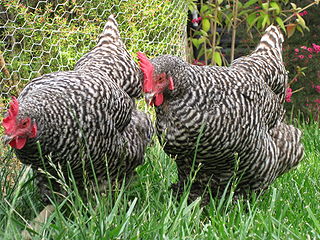
The Plymouth Rock is an American breed of domestic chicken. It was first seen in Massachusetts in the nineteenth century and for much of the early twentieth century was the most widely kept chicken breed in the United States. It is a dual-purpose bird, raised both for its meat and for its brown eggs. It is resistant to cold, easy to manage, and a good sitter.

Indian Runners or Runner ducks are a breed of Anas platyrhynchos domesticus, the domestic duck. They stand erect like penguins and, rather than waddling, they run. They were bred on the Indonesian islands of Lombok, Java and Bali. These ducks do not fly and only rarely form nests and incubate their own eggs. They run or walk, often dropping their eggs wherever they happen to be. Egg production has been measured at over 173 eggs per year; much higher claims have been made without reliable evidence. The breed arrived in the Western world in the 19th century; they have since been bred to have a wide variety of colours.

The Campbell is a British breed of domestic duck. It was developed at Uley, in Gloucestershire, England, at the turn of the 20th century; being introduced to the public in 1898 and the Khaki variety in 1901.
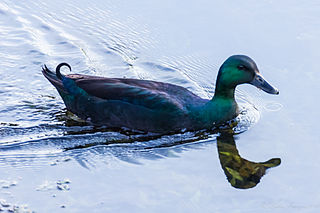
The Cayuga is an American breed of domestic duck. It was introduced to the Finger Lakes region of New York State in about 1840, and is named for the Cayuga people of that area. Until the last years of the nineteenth century it was the principal duck reared for meat in the United States. In the twenty-first century it is kept mainly for ornament. The plumage is black with iridescent beetle-green lights.
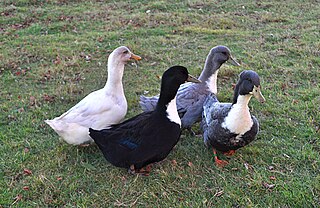
The Swedish Blue or Blue Swedish is a Swedish breed of domestic duck. It originated in the former dominion of Swedish Pomerania – now in north-west Poland and north-east Germany – and is documented there from 1835. It is closely similar to the Pomeranian Duck from the same general area, differing mainly in its white primary feathers.

The Rouen is a heavyweight breed of domesticated duck. Rouens are raised primarily for meat, exhibition, or as general purpose ducks. Since they are not prolific egg layers, Rouen ducks are most commonly bred for their meat. The breed originated in France sometime before the 19th century.

The Call is a historic breed of small domestic duck. It is believed to have originated in the Netherlands, where the earliest descriptions and depictions of it date from the seventeenth century. It is similar in appearance to some other breeds of duck, but is much smaller, with a round head and very short bill. Ducks, but not drakes, are very loquacious and noisy, with a piercing high-pitched call which can be heard from far away.

The Orpington or Buff Orpington Duck is a breed of domestic duck. It is a dual-purpose breed used for meat and egg production. It is capable of laying up to 220 eggs a year. Originally created by William Cook of Orpington, Kent, England, from the selection of mis-marked Blue Orpington Ducks; Cook was also the developer of the Orpington chicken. The breeds used in the development of the breed included Cayuga, Indian Runner, commercial Aylesbury and Rouen. It is proposed that Cook's intentions for the breed were to capitalize on the growing demand for the buff colour pattern. The Buff Orpington Duck was introduced to the public at the Dairy Show, the Agricultural Hall (q.v.), Islington, London in October 1897. It is considered a threatened breed by the ALBC. This breed was admitted to the British Poultry Standard in 1910 and the American Poultry Associations Standard of Perfection as the 'Buff Duck' in the Medium class in 1914. The Orpington duck is available in three colour varieties: Buff, Blond and Brown. The Buff Orpington is an unstable colour due to a blue dilution gene which means that from the offspring, all three colour variations will appear.

The Magpie is a British breed of domestic duck. It has distinctive black and white markings reminiscent of the European magpie, and is a good layer of large eggs.

The Ancona is a breed of domestic duck, characterised by an unusual and variable broken-colored plumage pattern. It is not clear whether it originated in the United Kingdom or in the United States. It is not recognised or listed by the American Poultry Association, by the Entente Européenne d'Aviculture et de Cuniculture, or by the Poultry Club of Great Britain.

The Buckeye is an American breed of chicken. It was created in Ohio in the late nineteenth century by Nettie Metcalf. The color of its plumage was intended to resemble the color of the seeds of Aesculus glabra, the Ohio Buckeye plant for which the state is called the 'Buckeye State'.
The Nankin Bantam or Nankin is a British bantam breed of chicken. It is a true bantam, a naturally small breed with no large counterpart from which it was miniaturised. It is of South-east Asian origin, and is among the oldest bantam breeds. It is a yellowish buff colour, and the name is thought to derive from the colour of nankeen cotton from China.
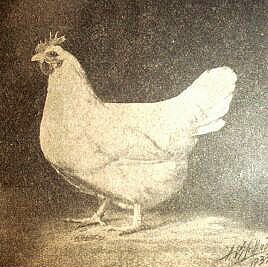
The Lamona is an American breed of chicken. It was developed from 1912 by Harry S. Lamon, who was the senior poultry expert of the Bureau of Animal Industry, at the Beltsville Agricultural Research Center of the U.S. Department of Agriculture in Beltsville, Maryland.

The Silver Appleyard is a British breed of domestic duck. It was bred in the first half of the twentieth century by Reginald Appleyard, with the aim of creating a dual-purpose breed that would provide both a good quantity of meat and plenty of eggs.
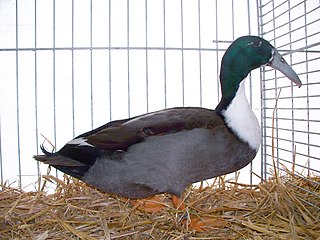
The Hook Bill or Dutch Hookbill, Dutch: Kromsnaveleend or Krombekeend, is a Dutch breed of domestic duck, named for its unusual down-curved beak. It is documented in both text and images from the late seventeenth century onwards. It originated in the province of North Holland, and so may also be known as the Noord Hollandse Krombekeend. Speculation that it originated in Asia, or is related to the Indian Runner, is apparently unsubstantiated.
The Shetland goose is a breed of domestic geese that originates in the Shetland Islands of Scotland. Like the other breeds of livestock native to the islands, the Shetland goose is small in stature, generally weighing between 12 and 14 pounds. They are very hardy and exceptionally good foragers, and are able to largely sustain themselves through grazing.

The Saxony is a German breed of domestic duck. It was bred in Saxony in the 1930s, but because of the Second World War was recognised only in 1957.

The Golden Cascade is a breed of domestic duck developed in the United States. In 1979, David Holderread of Corvallis, Oregon set out to breed a duck that was fast growing, active, laid eggs well, and was auto-sexing. By the mid-1980s, the Golden Cascade was introduced to the market. It is not yet admitted to the American Poultry Association's Standard of Perfection.



















